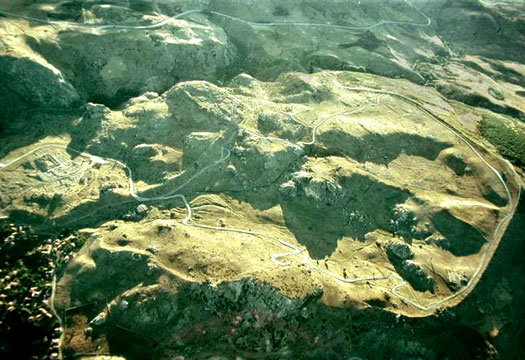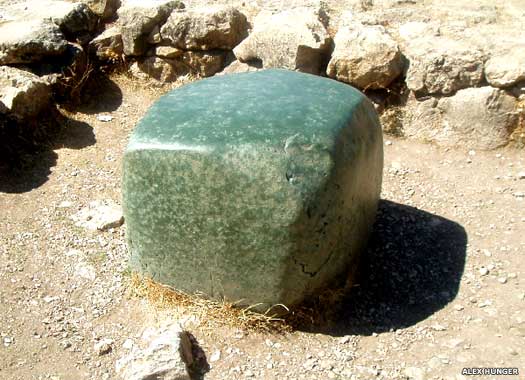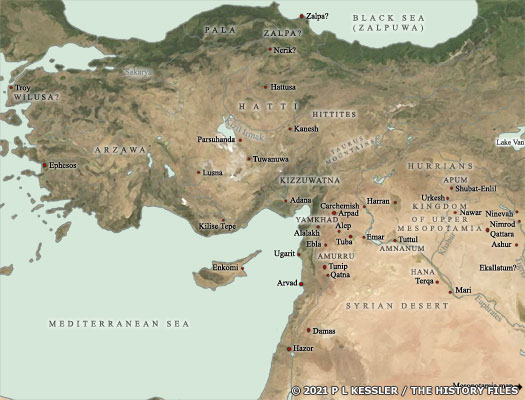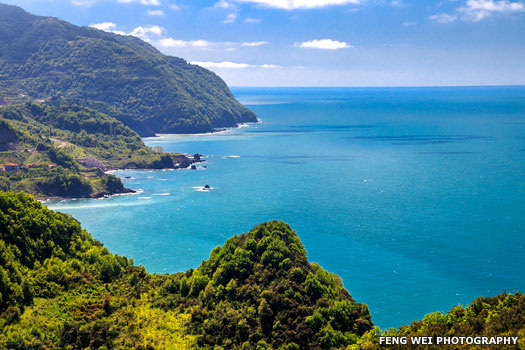
| HATTI (HATTUSA) Incorporating the city of Zalwar :
The Hatti were quite possibly an aboriginal people in central Anatolia, and were therefore related to the Neolithic farmers who had branched out into Old Europe to found the Sesklo culture of the seventh millennium BC. The Hatti (Hattians or Hattis) occupied the region inside the arc of the River Kizil Irmak in modern Turkey. The first settlements in this region date from the Chalcolithic period of the sixth millennium BC, when small, widely scattered hamlets appeared most particularly on mountain slopes and rocky outcroppings. Early in the third millennium BC, towards the end of the Early Bronze Age, a Hattian settlement developed, marking the beginning of continuous occupation at the site of Hattusa. These people spoke a non- Indo-European language called Hattic which was probably related to the Circassian language group. Their eastern neighbours probably spoke a very similar tongue, those neighbours being the Khaldi (Chalybes or Chaldoi, whose easternmost groups were later part of Urartu and some of whom may also have formed the Halizones).
The Hatti didn't have a written language of their own, but their scribes probably used cuneiform script for trade dealings, especially after the Assyrians set up trading posts in the region. Apparently possessing a series of city states and small kingdoms from the mid-third millennium BC, early on they probably participated in trade with the great city states of Sumer, which needed cedar and hardwoods from the Amanus mountains. In the villages of the Amq plain, at the foot of the Amanus, findings of Ubaid Period painted pottery and then the burnished wares of Uruk bear witness to the fact that the timber trade was active even in those early days.
From at least 2500 BC onwards, the Hatti occupied the mountain city state of Hattusa (modern Bogazkale in Turkey), surrounded by arable land and pasture for sheep, as well as some woodland. The Hatti were probably also responsible for the states at Hassum, Kanesh, Purushanda (possibly), and Zalwar, among others (the known rulers of Zalwar are shown in green below in order to distinguish them from the rulers of Hattusa). While at their height, they witnessed Luwians settling to their south after around 2300 BC, to emerge in the states of Arzawa and Kizzuwatna. In the eighteenth century BC, their homeland was invaded by the Hittites, and within a century or so they had been conquered and replaced. However, their region of Anatolia was still known as the 'Land of the Hatti' until 630 BC, as described by the Assyrians. It is likely that the victorious Hittites replaced the Hatti as a new ruling elite and its associated servicers, while the native Hatti found themselves pushed down towards the lower rungs of society. Their descendants are still there, part of the blending that makes up modern Turks.
(Information by Peter Kessler, with additional information from Warfare in the Ancient Near East to 1600 BC: Holy Warriors at the Dawn of History, William J Hamblin (Routledge, 2006), from The Horse The Wheel and Language: How Bronze Age Riders from the Eurasian Steppes Shaped the Modern World, David W Anthony, from The Kingdom of the Hittites, Trevor Bryce (1998), from The Hittites, O R Gurney (1991), from The Hittites, J G Macqueen (1996), and from External Links: A Brief History of Hattusha/Bogazköy (from Archive.today), and Proclamation of Anittas (Hittite Online, Linguistics Research Center, University of Texas at Austin), and Anatolian Conference abstracts, Emory University, and Linguistics Research Center (University of Texas at Austin), and The historical geography of north-central Anatolia in the Hittite period: texts and archaeology in concert, Roger Matthews & Claudia Glatz (Anatolian Studies Vol 59, 2009, pp 51-72, available via JSTOR).)
c.2700 BC :
Trade routes in the Anatolia region are already well established with the cities of Sumer. Such trade seems to flow via the city state of Alakhtum at this time, with its king building a stylish and expensive palace out of the income collected thanks to this trade. In Sumer such energetic trade may be the result of rebuilding work after the flood has affected cities such as Kish.
The Hittite 'Old City' (which was probably based on the ruins of the Hatti city) comprised an area of almost one square kilometre, being protected by a massive fortification wall while on the high ridge of Büyükkale was the residence of the 'Great King', and the city lay on the slope below to the north-west, reaching towards the valley below c.2500 BC :
The
Hatti establish a city state centred on Hattousha (Hattusa), one
of many such small states in the region which are supported by farming
and which produce a distinctive, highly-burnished pottery. Nearby
Kanesh is probably also a Hatti state. The Hattian Early Period
begins here but, already, around them are settling newly-arriving
waves of Indo-Europeans of the South Indo-European group - generally
agreed to have been the first to migrate out of the original Indo-European
homeland to the north of the Black Sea and Caspian Sea. These are
the Luwians, and they will eventually form two major regional states
along the southern Anatolian coast, Arzawa and Kizzuwatna.
c.2334 - 2279 BC :
The later Hittite 'King of Battle' epic relates how Sargon of Akkad campaigns in the region on the invitation of merchants from Purushanda to attack their city (possibly Semites who wanted to initiate trade between the two states). He marches against the city and attempts to break down its walls, winning a relatively brief success. While Purushanda later becomes a core Hittite city, at this date it seems to be a significant and independent power of its own, and may not be a Hattian domain.
late 23rd cent BC :
Pamba : King of the Hatti state based at Hattusa. Fought Naram-Sin.
The green cubic stone at Hattusa was probably a gift to the later Hittite rulers of the city from the Egyptian pharaoh with whom they signed a peace treaty in 1258 BC c.2200 BC :
Local art in Hatti (as well as at Troy), while still primitive, has already achieved a level of stylisation in the region which is independent of Sumerian influences, and metalwork is elaborately decorated, as discovered in the royal tombs of Alaca Höyük. However, this point seems to mark the end of a period of success, as shown by a layer of destruction and the burning of the Hatti citadel (part of a decline that is seen across the entire region, including at Tuba in Syria, Eridu and Uruk in Sumer, and in Egypt). The culture which is illustrated by the tomb's objects does not continue into the next historical phase, that of Kütepe.
c.2000 BC :
The Assyrians establish trading colonies at Hattusa and Kanesh (Nesha or Nesa, its local name), which may well be within Hattian territorial boundaries. The local Kütepe Period civilisation (2000-1700 BC) which is based at Kanesh is at its height between 1950-1800 BC, possibly due to the prosperity this very trade brings in. This is the start of the Hattian Middle Period.
At the start of the second millennium BC, a series of small city states in Anatolia which had existed for perhaps a millennium now began to emerge from obscurity c.1772 - 1769 BC :
Anum-Herwa / Anum-Hirbi : King of Zalwar. A vassal of Mari.
Anum-Herwa is a contemporary of Zimri-Lim of Mari, and he begins his career as that king's vassal. In years four and five of the latter's reign, Anum-Herwa is mentioned as being king of Zalwar (currently unlocated but possibly Koyuncu Höyük, near the marshes north of the Lake of Antioch). In years seven and eight he appears as king of Hassum of which he has taken control. He now ranks as an important Anatolian king, and may still be alive at the time at which Anitta leads the Hittites.
c.1769 - ? BC :
Anum-Herwa / Anum-Hirbi : King of Hassum after capturing the city.
mid-18th cent BC : PiyustiKing of Hattusa. Defeated by the Hittites.
mid-18th cent BC :
Piyusti is defeated twice by the Hittite king, Anitta, and then the capital at Hattusa is stormed, conquered, and destroyed. The cities of Zalpa, Salatiwara, and Purushanda are also defeated, the latter without even fighting. Purushanda may occupy a position of pre-eminence in the region, and its surrender indicates the end of local resistance to Hittite rule. Anitta's kingdom collapses after his death, however, and Kanesh is destroyed shortly afterwards by a king of Salatiwara. The Hittites remain centred on Kussara for a further century and it is possible that the Hatti recover to some extent, but their city at Hattusa is not rebuilt.
Zalpa was probably located on the southern Black Sea coast, presumably within easy reach of its neighbouring cities of Kanesh, Kussara, Hattusa, Purushanda, and Zalwar, plus others c.1650 BC :
Under Hattusili, heir to the throne of Kassura, the Hittites rapidly defeat their enemies in central Anatolia, re-taking Hattusa which becomes their capital. This point marks the definite end of Hattian civilisation as it is totally submerged by that of the Hittites, and the populace is integrated into Hittite society (although their artwork skills survive, and most of their gods too). Hattians still form the majority of the population, as can be seen in later images which show long-nosed soldiers and populace, but leaders who look noticeably different.
Source :
https://www.historyfiles.co.uk/ |




